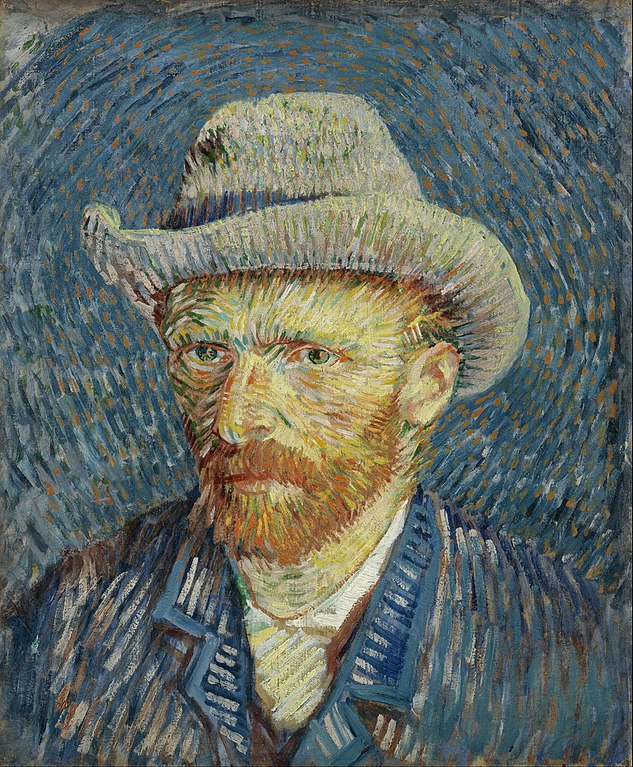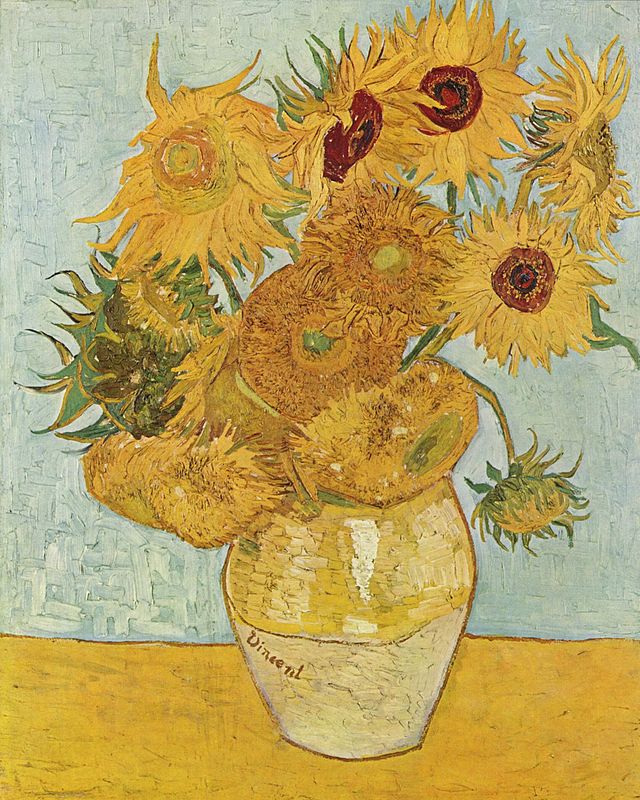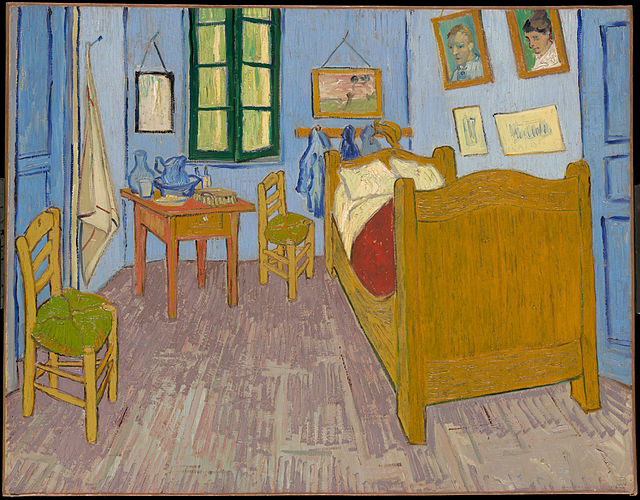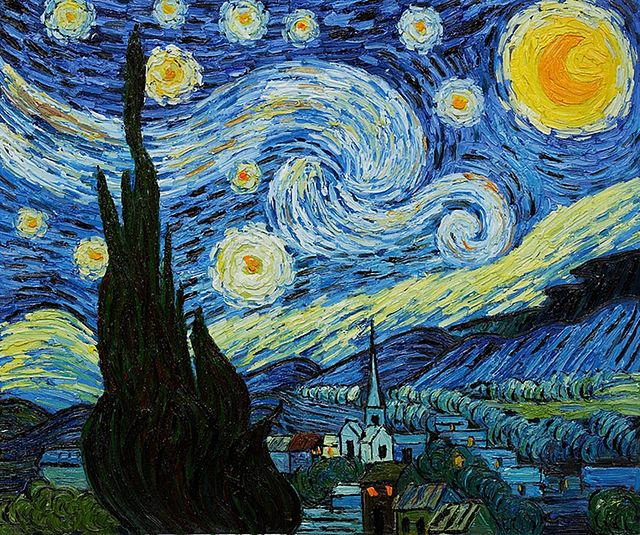

“One cannot write how grieved one is nor find any comfort. It is a grief that will last and which I certainly shall never forget as long as I live; the only thing one might say is that he himself has the rest he was longing for…Life was such a burden to him; but now, as often happens, everybody is full of praise for his talents…Oh Mother! he was so my own, own brother.”
From a letter of Theo’s to his mother
Vincent
Vincent van Gogh’s life and work are so intertwined, that it is hardly possible to see his pictures without reading in them the story of his life: a life which has been described so many times that it is by now the stuff of legend.
Vincent van Gogh was born at in Zundert, Netherlands.
In this blog, we will sample van Gogh’s most celebrated works, with concise introductions.
SKULL WITH BURNING CIGARETTE

This unusual work is housed in the Van Gogh Museum in Amsterdam. Completed in 1886, it portrays a skeleton smoking a cigarette. The work has roused many interpretations, including a depiction of mortality and a prophetic cry of the dangers of tobacco. In the next two years van Gogh painted two other paintings with skulls, illustrating his fascination with the subject.
PORTRAIT OF THE POSTMAN JOSEPH ROULIN

Van Gogh painted the family of postman Joseph Roulin in the winter of 1888.
The family included Joseph Roulin, the postman; his wife, Augustine; and their three children. Van Gogh described the family as “really French, even if they look like Russians.” Over the course of just a few weeks, he painted Augustine and the children several times.
Van Gogh used colour for dramatic effect. Each family member’s clothes are portrayed in bold primary colours and van Gogh used contrasting colours in the background to intensify the impact of the work.
Completed in 1888, this painting is housed in the Museum of Fine Arts, Boston.
It depicts Joseph, the father of the family.
Van Gogh and the postman became good friends and drinking companions. Van Gogh compared Roulin to Socrates on many occasions. In appearance, Roulin reminded the painter of the Russian novelist Fyodor Dostoyevsky, who had the same broad forehead, nose and shape of beard.
STILL LIFE: VASE WITH TWELVE SUNFLOWERS

Van Gogh completed two series of still life paintings of sunflowers.
Van Gogh had hoped to welcome and impress his artist friend Gauguin with a Sunflowers work, which he hung in the guest-room of his Yellow House where Gauguin stayed.
“It is a kind of painting that rather changes in character, and takes on a richness the longer you look at it. Besides, you know, Gauguin likes them extraordinarily. He said to me among other things, ‘That…it’s…the flower.’ You know that the peony is Jeannin’s, the hollyhock belongs to Quost, but the sunflower is somewhat my own.”
In a letter to Theo
The work is accentuated with deep sky blues and golden oranges, representing a time when van Gogh was truly happy, welcoming his friend Gauguin, with dreams of establishing an artists’ commune.
As van Gogh anticipated, his sunflower works have gone on to largely symbolise his corpus of works, with no Van Gogh exhibitions since 1901 voluntarily missing them out. There have been many forgeries of these works and they have also encouraged record-setting prices at auctions.
PORTRAIT OF DR. GACHET

This painting depicts Dr. Paul Gachet, who took care of van Gogh during the final months of his life.
There are two authenticated versions of the portrait, both painted in June 1890 at Auvers.
They portray the doctor sitting at a table and leaning his head on his right arm, but they are differentiated in colour and style.
In the more famous version of the painting, two yellow books as well as the purple medicinal herb foxglove are displayed on the table.
Van Gogh’s first impression of Gachet was unfavourable, as shown when he wrote to his brother,
“I think that we must not count on Dr. Gachet at all. First of all, he is sicker than I am, I think, or shall we say just as much, so that’s that. Now when one blind man leads another blind man, don’t they both fall into the ditch?”
However, a letter dated two days later to their sister Wilhelmina, he remarked,
“I have found a true friend in Dr. Gachet, something like another brother, so much do we resemble each other physically and also mentally.
In 1990, the portrait fetched a record price of $82.5 million at auction in New York and so the work now resides in a private collection.
VINCENT’S BEDROOM IN ARLES

There are three versions of this painting, which are easily differentiated by the pictures depicted on the wall to the right.
The painting portrays van Gogh’s bedroom in Arles, Bouches-du-Rhône, known as his Yellow House.
In the room, the door to the right opened to the upper floor and the staircase and the door to the left served the guest room he held prepared for Gauguin. The window in the front wall looked out towards Place Lamartine and the public gardens.
In a letter to Theo, van Gogh wrote,
“it simply reproduces my bedroom; but colour must be abundant in this part, its simplification adding a rank of grandee to the style applied to the objects, getting to suggest a certain rest or dream.
THE RED VINEYARD

Completed in early November 1888 in Arles, this painting is supposedly the only work sold by van Gogh during his lifetime.
The Red Vineyard was acquired by the famous Russian collector Sergei Shchukin.
It was then nationalised by the Bolsheviks with the rest of his collection and eventually passed over to the Pushkin Museum of Fine Arts in Moscow.
SELF-PORTRAIT WITH BANDAGED EAR

This haunting portrait was completed in January 1889 and is housed in the Courtauld Institute Galleries, London.
On 23 December 1888, frustrated and ill, van Gogh confronted Gauguin with a razor blade, but in panic, left and fled to a local brothel. Intensely lonely at the time, he often visited the prostitutes at a brothel on Rue du Bout d’Aeles as his single point of sensuous contact with other people. While there, he cut off his left ear, which he wrapped in newspaper and handed to a prostitute named Rachel, asking her to “keep this object carefully.
He staggered home, where he was later found by Gauguin lying unconscious, his head covered in blood.
Van Gogh was taken to a hospital and remained in a critical state for several days. He asked for Gauguin continually, but the Frenchman stayed away. Gauguin told one of the policeman attending the case,
“Be kind enough, Monsieur, to awaken this man with great care, and if he asks for me tell him I have left for Paris; the sight of me might prove fatal for him.”
In January 1889, van Gogh returned to the Yellow House, but spent the following month between the hospital and home, suffering from hallucinations and delusions that he was being poisoned.
In March, the police closed his house after a petition by 30 townspeople, who called him the ‘redheaded madman’.
At this difficult time van Gogh painted this self-portrait, clearly emphasising the bandaged ear, which covers the left side of his face, contrasting strongly with the bright, vivid colours of the Japanese woodcut on the wall. The thick coat covering the artist might suggest that he seeks protection from the outside world, if not the horrors in his mind.
THE STARRY NIGHT

Housed in the Museum of Modern Art in New York, this is one of the most famous paintings ever created and considered by many to be van Gogh’s masterpiece.
Painted in September 1888, it depicts the view outside van Gogh’s sanatorium room window at Saint-Rémy-de-Provence at night, though it would have been painted from memory during the day.
In a letter to Theo, van Gogh explained,
“it does me good to do what’s difficult. That doesn’t stop me having a tremendous need for, shall I say the word — for religion — so I go outside at night to paint the stars”
In mid-September 1889, following a heavy crisis which lasted from mid-July to the last days of August, he thought to include the painting in the next batch of works to be sent to Theo in Paris.
In order to reduce the shipping costs, he withheld three of the paintings, including The Starry Night, revealing his own critical view of the work.
The famous painting depicts the village of Saint-Rémy under a swirling sky, in a view from the asylum towards the north.
Conclusion
Anxious and depressed, Vincent van Gogh produced more than 2000 artworks, yet sold only one in his lifetime.
A self-made artist, his work is known for its rough and emotional beauty and is amongst the most popular in the art market today.
Van Gogh Worldwide is a new project by a group of Dutch museums which presents a digital collection of over 1,000 of the artist’s masterpieces. Building off the digitized collection begun several years ago by the Van Gogh Museum in Amsterdam, almost half of the post-Impressionist works of this prolific artist are now available to view—with scholarly commentary—from the safety of your own home.
Have a look at this beautifully curated digital archive.
 Van Gogh: The Life (RANDOM HOUSE)
Van Gogh: The Life (RANDOM HOUSE)
 Lined Notebook: A Beautiful Vintage Botanical Print Cover Lined Notebook
Lined Notebook: A Beautiful Vintage Botanical Print Cover Lined Notebook
Disclaimer: All recommendations are impartial and based on user experience, with no bias to the products or the brand. The products in this post may contain affiliate links.
[…] 8 of Vincent Van Gogh’s most Famous Paintings that Capture the Artist’s Fascinating Mind […]